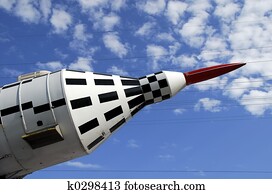
In general, the constraints and goals for atmospheric reentry conflict with those for other high-speed flight applications during reentry a high-drag blunt reentry shape is frequently used, which minimises the heat transfer by creating a shock wave that stands off from the vehicle, but some very-high-temperature materials may permit sharper-edged designs. Materials used for ablative shields include, for example carbon phenolic, polydimethylsiloxane composite with silica filler and carbon fibers, or as in of some Chinese FSW reentry vehicles, oak wood. The nose cone is typically made from plastic, balsa wood, hardwood, fiberglass, or styrofoam. It could be conical in shape, but at subsonic speeds a rounded shape gives lower aerodynamic drag. Another design strategy is using ablative heat shields, which get consumed during operation, disposing of excess heat that way. The nose cone of the rocket has a shape that causes the air to flow smoothly around the rocket. Pyrolytic carbon is one choice, reinforced carbon-carbon composite or HRSI ceramics are other popular choices. hypersonic speeds or atmospheric reentry of orbital vehicles) have to be made of refractory materials. The velocity and purpose that the rocket is going to be use for is often the biggest consideration that is looked at when choosing a nose cone.


The article on nose cone design contains possible shapes and formulas.ĭue to the extreme temperatures involved, nose cones for high-speed applications (e.g. The shape of the nose cone must be chosen for minimum drag so a solid of revolution is used that gives least resistance to motion. In a satellite launch vehicle, the nose cone may become the satellite itself after separating from the final stage of the rocket, or it may be used as a payload fairing to shield the satellite until out of the atmosphere, then separating (often in two halves) from the satellite.Īir India Boeing 777-300ER connected to a jet bridge. Much of the fundamental research related to hypersonic flight was done towards creating viable nose cone designs for the atmospheric reentry of spacecraft and ICBM reentry vehicles. On a suborbital rocket vehicle it consists of a chamber or chambers in which instruments, animals, plants, or auxiliary equipment may be carried, and an outer surface built to withstand high temperatures generated by aerodynamic heating. Nose cones are also designed for submerged watercraft such as submarines, submersibles and torpedoes, and in high-speed land vehicles such as rocket cars and velomobiles. A nose cone is the conically shaped forwardmost section of a rocket, guided missile or aircraft, designed to modulate oncoming airflow behaviors and minimize aerodynamic drag.


 0 kommentar(er)
0 kommentar(er)
